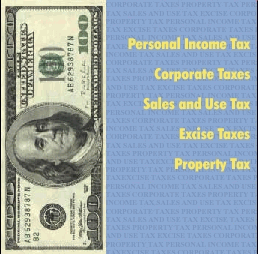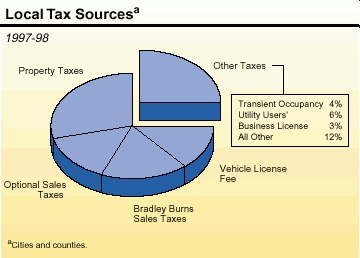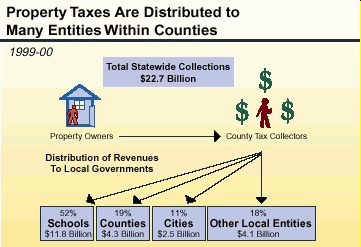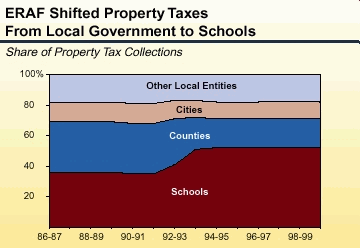
 |
California's Tax SystemA PrimerChapter 6 |
Local taxes account for about 35 percent of total (city and county) local government revenues in California, and amounted to in excess of $20 billion in 1997-98. The main sources of local tax revenues include the property tax (29 percent), the local component of the sales and use tax (SUT) (32 percent), the vehicle license fee (VLF) (14 percent), and a variety of "all other" levies (25 percent). The latter include the utility users' tax, business license tax, transient occupancy tax, and various other levies. The local SUT was discussed in Chapter 3. The VLF was discussed in Chapter 5 as a motor vehicle-related tax. This section focuses on the property tax and all other local taxes.

The property tax is a major source of tax revenue for California's local governments, including cities, counties, school districts, and special districts. Property taxes have been part of California's tax structure since 1849, and are among the most stable of its revenue sources. In 1999-00, the property tax raised an estimated $22.7 billion. The current distribution procedures and statewide average allocation percentage are shown in the accompanying figure.

Property Tax Base. The property tax applies to all classes of property--residential, commercial, industrial, agricultural, open space, timberland, vacant land, and certain personal property. Real property includes land, buildings, fixtures, mineral rights, and other components. Personal property is generally limited to businesses and includes things like equipment, machinery, and aircraft.
Certain types of property are exempt, such as property owned by governments or charities, household personal property, automobiles, securities, and business inventories.
Property Assessment. The property tax is based on the assessed value of real and personal property in the state. Most property is assessed locally by county assessors, although certain types of property--including railroads, utilities, and other similar property--is assessed by the state. Prior to the adoption of Proposition 13 in 1978, all property was assessed at the market rate and a locally determined tax rate was applied to the assessed value in order to calculate the total tax levy.
The adoption of Proposition 13 resulted in a number of restrictions on the property tax which limit the ability of local governments to raise revenues from this tax.
Locally assessed real property is assessed based on the acquisition value (while other property continues to be assessed at market value).
For most other property (locally assessed personal property or state assessed real property), the assessment practice continues to be based on market value. Measures of market value include purchase price, adjusted sales price of comparable properties, replacement cost, and discounted cash-flow valuation.
Property Tax Rate. The countywide property tax rate is limited to 1 percent of assessed value. Additional levies are permitted for voter-approved general obligation debt. For 1998-99, the average countywide tax rate was 1.069 percent, with the highest at 1.167 percent for the City and County of San Francisco.
Property Tax Allocation. As a percent of total revenues, the share contributed by the property tax varies widely among different governmental entities. Proposition 13 gave the state responsibility for allocating the property tax among local governments. In 1992 and 1993, the state shifted property tax allocations from cities, counties, and special districts to schools to reduce state costs. This was accomplished through a mechanism known as the Educational Revenue Augmentation Fund (ERAF).

The property tax has numerous issues associated with it.
The utility users' tax (UUT) accounts for approximately 13 percent of city general purpose tax revenues. It is assessed on the consumer of one or more of the following services: electricity, gas, cable television, water, and telephone. Some counties also levy the UUT. Tax rates are set by the governing body and range from 0.5 percent to 12 percent. Local government UUT revenues totaled more than $1.3 billion in 1997-98.
The business license tax (BLT) is a type of excise tax imposed on businesses for the privilege of operating within a city or county. The tax is most commonly based on gross receipts or levied at a flat rate. Cities rely on the business license tax for roughly 7 percent of general purpose tax revenues. The BLT revenues contributed more than $700 million to local governments in 1997-98.
The transient occupancy tax (TOT) is imposed on occupants for the privilege of occupying a motel, hotel, or similar room. The tax represents an attempt on the part of many local governments to "export" a portion of the tax burden to nonresidents and/or to recoup the costs imposed by nonresidents.
Cities and counties collected nearly $900 million in TOT revenues in 1997-98.
Local governments impose a variety of other general taxes, including: documentary transfer taxes, admissions taxes, and parking taxes. In addition, special taxes such as the Mello-Roos Community Facilities Tax, library services tax, parcel tax, and police and fire services tax are also imposed by some local governments. These vary widely across different types of local governments.
Ad Valorem Tax--A tax assessed based on the dollar value of an item or activity. Typical examples are property and sales taxes. Ad valorem taxes contrast with per-unit taxes, such as California's alcoholic beverage and cigarette taxes, which are assessed at a fixed dollar amount per unit of the item purchased.
Adjusted Gross Income--An amount calculated for income tax purposes which equals total income minus various exclusions, exemptions, and adjustments.
Alternative Minimum Tax (AMT)--An additional tax that must be computed by individual and corporate taxpayers who take advantage of certain special tax preferences. If this tax exceeds the regular tax liability, the excess amount is separately assessed. In addition, the AMT can reduce the amount of tax credits that can be claimed, even if a separate add-on AMT liability is not owed. The underlying intent of the AMT is to ensure that some tax is paid by those who claim special tax preferences. The state's AMT is (in many respects) similar to the federal AMT.
Bracket Creep--Since monetary wages and other types of compensation often go up with inflation, inflation can "push" taxpayers into higher tax brackets, even though their "real" income may be unchanged. This can inadvertently lead to a higher personal income tax (PIT) marginal tax rate being applied and increased tax liabilities being assessed.
Capital Gains--Income or profit from the sale of capital assets, such as real or personal property, stocks and bonds, and other property held by taxpayers. Certain capital losses can occur as well as capital gains.
Carryback or Carryforward--The amount of business-related losses from one year that can be used to offset taxable income in past years (a carryback) or in future years (a carryforward). Such losses are due either to the sale of capital assets or to the realization of a net operating loss (see below).
Credit--An amount which can be subtracted from the computed tax owed, and thereby reduce a tax liability. A credit is usually tailored to benefit specific categories of individuals or businesses, or encourage certain types of behavior. Examples are California's tax credits for business investment, research and development expenditures, and senior citizens.
Deduction--Amount subtracted from gross income to arrive at taxable income. Examples for individuals include home mortgage interest expenses and charitable contributions. Examples for businesses include employee salaries and depreciation charges for equipment.
Depreciation--Income tax deduction allowed for the decrease in the value of structures and capital assets due to use and obsolescence. Depending on the type of asset and the year placed in service, different methods for calculating depreciation are applicable.
Effective Tax Rate--Percentage of market value, income, or other taxed amount that a tax liability represents. Also known as the average tax rate.
Excise Tax--General term for a per-unit levy on the manufacture, sale, or use of a specific service or commodity. Examples include California's excise taxes on alcoholic beverages and cigarettes.
ExemptionRefers to the partial or complete exclusion from taxation of specified items, such as certain types of income under the PIT or transactions under the sales and use tax (SUT). Can constitute either a specified dollar or percentage amount, and can apply to specified types of individuals, businesses, property, institutions, sources of income, or other classifications. An example is the exemption of income from taxation of nonprofit organizations, as long as receipts received are related to the nonprofit activities of the entity.
IncidenceRefers to who bears the burden of a tax. Tax incidence can take two formseconomic and statutory incidence. Economic incidence involves who ultimately bears the cost of the tax. This may differ from statutory incidence, which is simply who initially pays the tax. For example, a landlord initially pays the property tax and thus has statutory incidence, whereas renters share in economic
incidence to the extent that the property tax is "passed on" to them in the form of higher rent.
Income ApportionmentThe process of determining the amount or share of a taxpayer's income that is allocable to a particular geographic jurisdictionsuch as Californiafor tax purposes.
IndexingThe annual upward adjustment under the income tax of marginal tax bracket boundaries, certain credits, and the standard deduction by the Consumer Price Index to compensate for inflation.
Marginal Tax RateThe income tax rate that is applied to the highest or last dollar of a taxpayer's income.
Marriage PenaltyThe amount by which the tax liability of a married couple exceeds their combined tax liability that would have existed had they not been married and filed as two single taxpayers.
Net Operating LossWhen the gross income of a business is exceeded by its allowable deductions, thereby causing a loss for tax purposes. In California, these losses may be carried forward and used to offset positive net income in future years, subject to various rules.
Nexus--Minimum threshold of "connection" or "presence" with a taxing jurisdiction that is required before taxes or tax collection responsibilities can be imposed on out-of-state individuals and businesses.
Passive Income--Income from trade or business activities for which a taxpayer does not actively participate, such as activities involving certain limited partnerships or rental properties. Net losses (called "passive losses") from these types of investments are limited in their use as offsets to regular "active" income, such as wages and salaries. Unused passive losses may be carried forward to offset passive income in the future, however.
Progressive Tax--Occurs when high-income taxpayers pay a greater percentage of their income in tax than do low-income taxpayers. A regressive tax involves the opposite situation.
Subchapter S Corporation--A "closely held" corporation with a relatively limited number of shareholders (75 or less), that qualifies for and elects special tax treatment, including the "pass through" of income to its shareholders for tax purposes.
Tax Base--The individuals, entities, objects, transactions, or other types of activities to which a tax is applied.
Tax Bracket--An upper- and lower-bounded range of taxable income levels within which a particular marginal tax rate is applied. California's PIT structure has six different income tax brackets for each of its five different filing statuses. As one moves to higher and higher brackets, a progressively higher marginal tax rate is applied.
Tax Expenditure Program--A tax provisionsuch as an exemption, exclusion, credit, deduction, deferral, or preferential tax ratewhich deviates from the "basic tax structure" and results in a reduction in government revenues that would otherwise be raised.
Throwback--In applying the income apportionment formula to multistate and multinational corporations, the sales of tangible personal property are usually attributed to the "destination state" to which the goods are shipped. However, when the destination state does not have jurisdiction to tax the corporation involved, the sales are "thrown back" to the geographic point of their shipment when making the apportionment calculation.
Value Added Tax (VAT)--A VAT is similar to a sales tax. However, rather than levied on a good's final sales value, it is assessed at each stage of the manufacturing process, based on the increase in the product's value attributable to that stage. Many countries throughout the world levy VATs, including many in Europe.
Water's-Edge Combination--One of two main methods for multistate and multinational corporations to use in combining the income of their various geographic activities in order to determine the amount of California taxable income. The water's-edge method combines activities from the 50 states of the U.S. and certain tax havens. The alternative method--worldwide combination--uses total income from all geographic jurisdictions throughout the world.
Worldwide Combination--The second of two main methods for multistate and multinational corporations to follow in combining their geographic income in order to determine the amount of California taxable income. In California, this method must be used if water's-edge election is not made.
UDITPA--Acronym for Uniform Division of Income for Tax Purposes Act. First drafted by the National Conference of Commissioners on Uniform Tax Laws in 1957, it provides a uniform method for allocating the income of multistate and multinational taxpayers among states for income tax purposes. Use of this method both keeps income from escaping taxation altogether and from being taxed more than once.
| Acknowledgments
This report was prepared by Mark A. Ibele and Jennifer Borenstein, with assistance from Michael Cohen, and reviewed by Jon David Vasché. |
Publications
To request publications call (916) 445-2375. This report and others are available on the LAO's World Wide Web site at www.lao.ca.gov. The LAO is located at 925 L Street, Suite 1000, Sacramento, CA 95814. |
Return to California's Tax System--A Primer Table of Contents